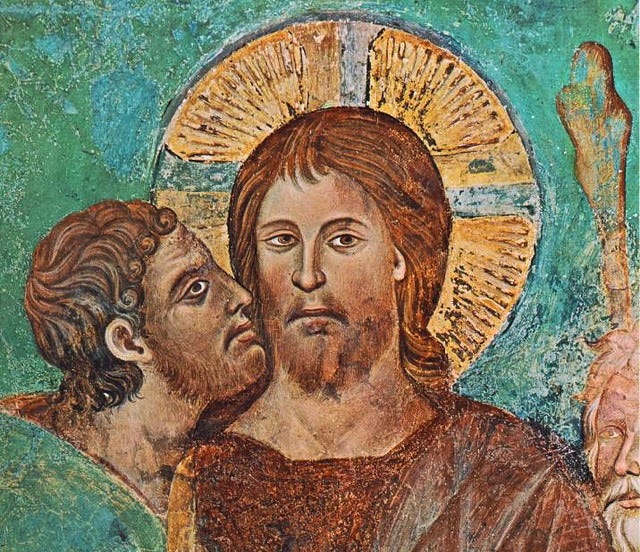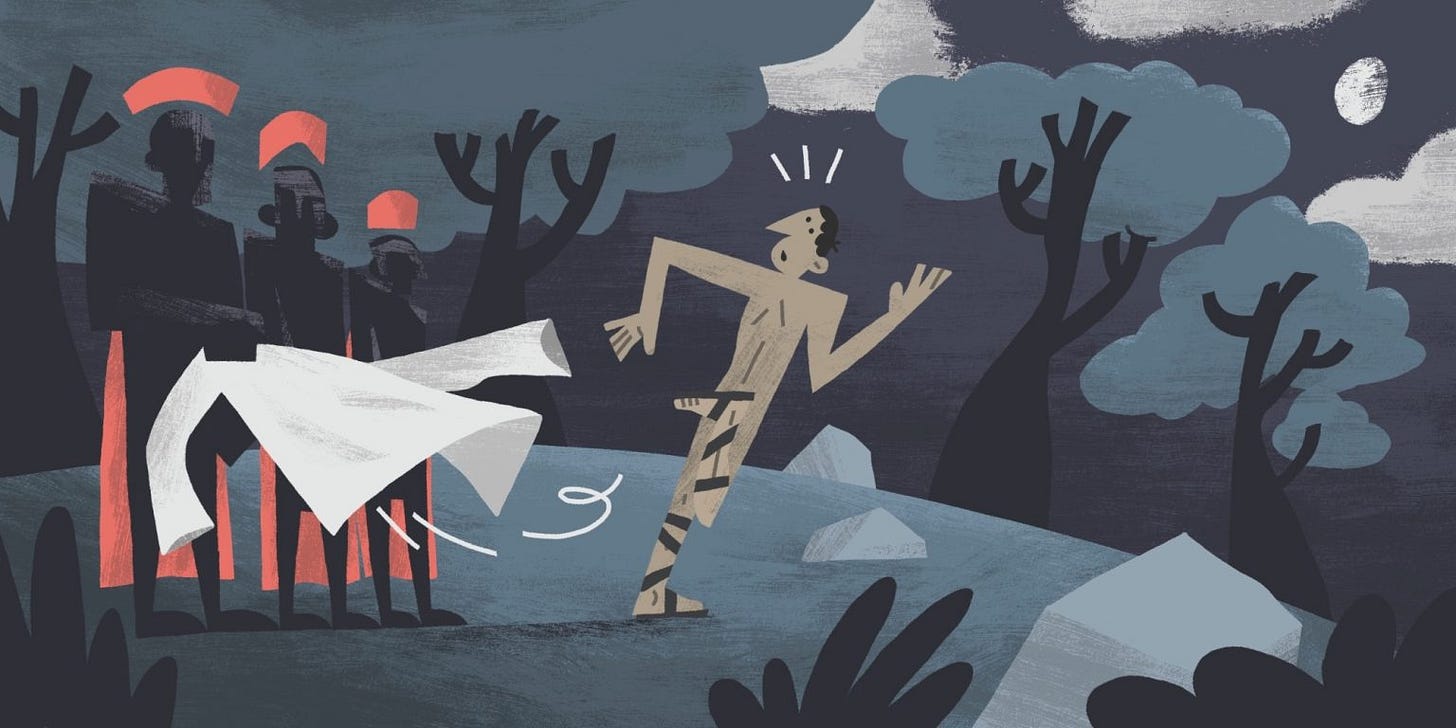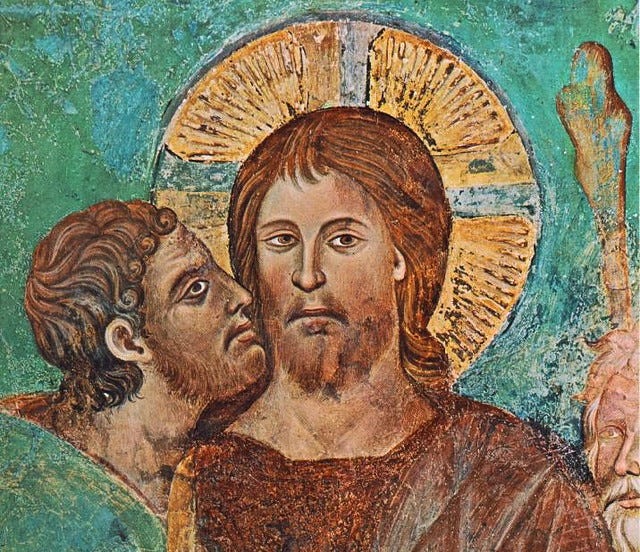Easter
1 Corinthians 15.1-11 & John 20.1-18
The writer— my favorite writer— Cormac McCarthy published two novels last year before his death, The Passenger and its companion Stella Maris. Towards the conclusion of the former, Bobby Western, the man at the center of the story’s mystery, comes for a final visit to the psychiatric facility where, roughly a decade earlier, his sister, Alicia, a math prodigy and diagnosed schizophrenic, had received care before taking her own life.
At the facility, Bobby Western speaks with a patient named Jeffrey who was close with Alicia. During their conversation, Bobby asks Jeffrey about his sister’s delusions:
Did she ever talk to you about the little friends that used to visit her?
Sure. I asked her how come she could believe in them but she couldnt believe in Jesus.
What did she say?
She said that she’d never seen Jesus.
But you have. If I remember.
Yes.
What did he look like?
He doesnt look like something. What would he look like? There’s not something for him to look like.
Then how did you know it was Jesus?
Are you jacking with me? Do you really think that you could see Jesus and not know who the hell it was?
Did he say anything?
No. He didnt say anything.
Did you ever see him again?
No.
But you never lost faith in him.
No. The Israelite heals. That’s all you need to know. Let me quote Thomas Barefoot to you. His word is not going to come back to him void. It’s going to do what he wants it to do. You might want to think about that.
Who is Thomas Barefoot?
A convicted murderer. Waiting to be executed by the State of
Texas…
Regardless of what this exchange may mean for the characters in the novel, what Jeffrey the psychiatric patient says about Jesus is not at all different than the claim that John the Evangelist makes about Jesus in the resurrection narratives.
The Risen Jesus cannot be recognized except as he wants to be.
When the Risen Jesus does want to be recognized, he cannot not be known.
The essential attribute of an appearance of the Risen Jesus is that he is he obviously not anyone else. What makes the Risen Jesus recognizable is precisely his unlikeness.
The disciples on the road back to Emmaus from Jerusalem on Easter morning— they have no idea their traveling companion is the recently dead Jesus. Not until Mary’s boy and Pilate’s victim breaks bread before their eyes are those eyes opened and the Risen Jesus recognized. The disciple named Thomas does not merely doubt the Easter news; Thomas does not recognize Jesus standing right in front of him until Jesus makes himself known to him. When the resurrected Jesus appears to the seven disciples along the Sea of Galilee, not a single one of them recognizes Jesus until Jesus commands them to cast their fishing nets starboard. Only then does Peter see, “It is the Lord!”
The Risen Jesus cannot be recognized except as he wants to be.
At the tomb, Mary mistakes Jesus for the gardener. Only by speaking her name does the Risen Jesus unveil himself to her. She’d come to his grave weeping and speaking of him merely as my Lord, “They have taken away my Lord, and I do not know where they have laid him.” Having unveiled himself to her, Mary runs from the tomb bearing witness to an identity of altogether different magnitude, “I have seen the Lord.”
When the Risen Jesus does want to be recognized, he cannot not be known.
On Easter night, the disciples are hiding behind locked doors. Despite Mary Magdalene having prepared them for the shock and awe earlier that morning, not a one of the disciples recognizes Jesus. The Risen Jesus says to them, “Peace be with you,” but still they do not know that its Jesus standing before them. Not until he reveals to them the holes in his hands and the wound in his pierced side do they recognize him— recognize him who appeared to them in a locked room, recognize him who stood amongst them without having passed through any door.
He simply appeared.
And then—
Exactly as he does on the road to Emmaus, he vanishes from their sight.
An odd body indeed.
What makes the Risen Jesus recognizable is precisely his unlikeness.
How did you know it was Jesus?
Are you jacking with me? Do you really think that you could see Jesus and not know who it was?
It was homecoming morning in Charlottesville in 1999. A month into
the fall semester of my fourth year at the University of Virginia, I’d planned
to skip the football game and was holed up at an empty carrel back in the stacks of the old Alderman library. I had a Bible on the desk for a class I was taking on the Gospel of John.
I also had a couple of LSAT prep books I’d already started to dog-ear and underline. At the library carrel on the other side of the row of bookcases was a tall, skinny, African American man wearing large headphones and an orange-and-navy track suit. He was busy highlighting a biochemistry textbook and taking notes on colored index cards. I’d started working on some sample problems from the prep book when suddenly there was a guy leaning against the end of the bookcase,
with his feet crossed nonchalantly and a crinkly, plastic-covered book in
his hands.
“What are you workin’ on?”
“Me? Um, studying for the LSAT,” I said.
“You’ve got a lot of lawyers in your family already, don’t you?”
“Yes,” I said. “Wait, how did you . . . ?”
“Don’t freak out, Jason,” he said, and pulled a different book—anthropology—from the shelf and flipped through it. “You like that other class a lot, don’t you?” he said, pointing at the Harper Collins Study Bible.
“Yeah, I really do,” I said. “But I like the other classes too. It’s hard, you know, knowing what God wants you to do with your life.”
“I just want you to enjoy your life,” he said.
I looked around for my roommates who surely must be punking me.
“Don’t do anything just to satisfy someone else’s expectations and don’t go down any path just to measure up to what the world defines as success.
That’s what I freed you from,” he said, smiling.
And then he pointed at the Bible and said, “If you’ll have the most fun doing that, then that’s what you should do.” He slid the book back in the empty space on the bookshelf.
He held out his arm to fist bump me and said, “Relax, man. You’re going to have a grand time.”
“Hold up,” I said, trying to find my voice, “I didn’t catch your name.”
But he’d already disappeared through the graffitied, heavy fire door at the end of the long row of stacks. After a few moments, I turned to the premed student on the other end of the bookcase.
Speaking up so as to be heard over his headphones, I said, “Did you catch that guy’s name?”
“What guy? Nobody been here, boss, but you and me.”
The Risen Jesus cannot be recognized except as he wants to be.
When the Risen Jesus does want to be recognized, he cannot not be known.
What makes the Risen Jesus recognizable is precisely his unlikeness.
Back in 1999—
When I was home for Christmas break, I shared the story of my encounter with my mentor, Dennis. When I finished, he took a sip of coffee from his tumbler and asked me, “What did he look like?”
I thought about it for a moment before I answered.
“I both could and could not say,” I said.
The Israelite heals. That’s all you need to know, I could’ve said to him.
And then I asked him a question, “Do you think it’s crazy that Jesus would show up in the stacks at the library?”
He laughed and replied, “I think what’s crazier are the places we know for sure that Jesus shows up.”
Then he leaned forward in his leather chair, like he was about to spill a secret in a whisper, “Word of advice. Don’t share your story with the ordination committee. They’ll send you to a therapist instead of a pulpit. It’s like they’ve not thought about what they’re claiming when they say, “Christ is risen indeed.””
What makes the Risen Jesus recognizable is precisely his unlikeness.
He is sui generis.
And of course this unlikeness should be his chief attribute. Jesus is the God-who-is-human; there is no other like him.
For instance—
Notice the detail John gives you.
First, Mary faces the tomb and addresses the angels, “They have taken away my Lord, and I do not know where they have laid him.”
Next, verse fourteen, John tells you that Mary turns.
Her back is to the tomb now.
And Mary “sees” Jesus but she doesn’t recognize him as Jesus.
Supposing him to be the gardener, she says to the man in front of her, “Sir, if you have taken him away, tell me where you have laid him, and I will take him away.”
And then— pay attention, John reports in verse sixteen that Jesus says to her, “Mary.”
And Mary turns, John says.
She turns in the direction of his voice. She turns towards the tomb so that her back is again to the man she took for the gardener. Mary’s facing the tomb when she says, “Rabboni! Teacher!”
She’s talking to the tomb.
And it’s from that same direction— from the “empty” tomb— that the voice of the Risen Christ corrects her. “Do not cling to me,” the Risen Jesus chastens her.
But again, note, John hasn’t said a word about Mary grasping anyone.
Rather, she’s facing the tomb and addressing it/him as “Teacher,” and it/he replies, “Do not cling to me.”
Which is to say, “I am not who you have known me to be. I am more than you have known me to be. I am free of even your memories of me.”
And then Mary turns again and she runs to tell the disciples and what she tells them is so mysterious, so unsettling, so incomprehensible that they turn to hide behind locked doors.
The tomb is not empty.
It’s full.
As the scripture says, the First Adam was a living being, a mortal, material body; the Second Adam, the Bible says, became a life-giving spirit. In other words, the resurrected body of Jesus Christ is a life-giving spirt.
Thus what makes the Risen Jesus recognizable is precisely this unlikeness.
Hector was an inmate at Trenton State Prison where I served as chaplain. Hector came to see me one hot summer day, his olive skin blanched white from fright. He looked both carsick and euphoric, like he’d just gotten off a rollercoaster.
“Man, no joke, Jesus Christ was just there—in my cell—last night before
lights out. He told me everything I ever done. And then he told it’s all forgiven. And then Jesus told me my kids are going to be alright. Preacher, don’t you get it? Everyone up in here is trying to get out and Jesus Christ broke in to tell me I’m forgiven.”
The Israelite heals— that’s all you need to know.
Hector looked absolutely terrified. but it didn’t stop him from asking me to baptize him the very next Sunday.
I thought about asking Hector how he knew it was Jesus.
But then I realized it would be a mistake to ask such a question. After all, the Bible tells us so. When the Risen Jesus does want to be recognized, he cannot not be known.
“Jesus broke in,” he told the congregation before I baptized him.
And I thought of Dennis telling me just a few years earlier, “I think what’s crazier are the places we know for sure that the Risen Jesus shows up.”
I think in some respects the Easter passages are so familiar to us that the staggering claims ventured by them simply slip past us. Consider, for example, the passage from the apostle Paul’s epistle to the church at Corinth. In rehearsing for them the gospel message they had first received from him— the gospel on which the church stands or falls, Paul reminds them that an item of the church’s gospel is that after Christ was raised on the third day, Jesus “appeared to the twelve.” This is both a strange claim and an unexpected appearance given the fact that, in between Christ’s resurrection and his ascension, there are only eleven apostles.
“The twelve” are no longer.
Like Jesus, Judas died on Good Friday. Judas is no longer alive come Easter. He not only handed Jesus over but by his hand he took his own life.
There are only eleven; there are not twelve.
Nevertheless, Paul reports clearly that “he appeared to the twelve.”
There is no possible way the risen Jesus could have appeared to all twelve of the apostles— at least, not on this side of the veil.
I think what’s crazier are the places we know for sure that Jesus shows up.
The Gospel of John calls Judas “the Son of Perdition.”
But 1 Peter insists that in between Holy Saturday and Easter Sunday the formerly dead but now rising Christ descended into hell in order to harrow it.
Jesus preached to the spirits imprisoned in hell.
Does that include even Judas?
If so, if not even Judas is beyond the reach of the risen Christ, then when the Old Testament proclaims that “love is as strong as death and [love’s] jealousy as fierce as the grave,” it is not speaking of love in the abstract. It’s referring concretely to Mary’s boy and Pilate’s victim.
Jesus is stronger than death.
His jealous love for those whom he loves is fiercer even than the grave.
Judas is Jesus’s Eurydice.
Jesus is Orpheus for us all.
The Israelite heals… in ways way beyond our imagining.
But Judas? Even Judas?
If there is hell for anyone, certainly there is hell for the sinner who betrayed God to a cross for the cash equivalent of $216.
As the theologian Karl Barth writes:
“It may be noted that in 1 Corinthians 15 Paul does not hesitate to say that the risen Jesus appeared to the twelve even when Judas could no longer complete the number…We do not know the outcome of the dead Judas being encountered by the risen Jesus. Therefore, the church will not then preach a universal salvation. But nor will the church preach a powerless grace of Jesus Christ or a wickedness of men and women which is too powerful for it…she will preach the overwhelming power of grace and the weakness of human wickedness in face of it…for in faith in Jesus Christ, we cannot consider any as lost. We know of only one abandoned, rejected, and lost. And God raised him from the dead. He was lost then found again in order that none should be lost apart from him.”
Karl Barth made this same point teaching a university course on the Apostles’s Creed. Standing in the bombed out ruins of Bonn, Germany at the end of the second world war, Barth— who had been exiled by the Nazis— taught that the meaning of Easter is that:
“Man’s legal status as a sinner is rejected in every form. Man is no longer seriously regarded by God as a sinner. Whatever he may be, whatever he has to reproach himself with, God no longer takes him seriously as a sinner.”
Therefore—
Of course he appeared to Judas.
Judas was no longer a sinner.
Judas is only a friend loved by Jesus.
To offer absolution to someone like Judas, it is so unlike anything that any of us would do for someone like him. But precisely that unlikeness— it is a sign of the resurrection as obvious as the empty tomb.
His word is not going to come back to him void. It’s going to do what he wants it to do.”
Four years ago almost to the day, I paid a pastoral call to a 97-year-old in the neighborhood. Vince was worried that “when the virus finally gets here, I’m exactly the kind of geezer who will have a bad go of it.”
“I try to have faith,” he told me, sipping his Folgers. “but other times I don’t know. I’ve tried to be good, but I’ve not been perfect. And before I tried to be good, I was…well, I was bad."
He went on in that vein for a few minutes, somewhere between anxious and genuinely terrified by the truth that none of us is getting out of life alive.
Finally, I interrupted him.
I had heard enough.
I stood up, made the sign of the cross over him, and said, “Vince, in the name of Jesus Christ and by his authority alone, I declare unto you the entire forgiveness of all your sins.”
“You can’t do that,” he argued.
“I can do it,” I replied, “And I must do it— our Lord demands it.”
“But…but you’re just…a guy.”
“No, I’m not just a guy. The Risen Jesus has an odd body and I’m an appendage of it.
“But I haven’t told you everything,” he said, “There’s a reason I’m all alone— you don’t know all the things I’ve done. You don’t KNOW!”
“I don’t need to know all the things you’ve done to forgive you in Jesus’s name,” I replied, “I know the name of the very first sinner the Risen Jesus forgave, and whatever you’ve done, trust me, you’ve got nothing on him.”
Vince was still weeping when I left him.
He doesnt look like something. What would he look like? There’s not something for him to look like.
Actually, that’s not exactly accurate.
Jesus himself tells us that he looks precisely like you and you and you and…gathered around loaf and cup.
As mysteriously as Mary talking to an empty tomb, this is his risen body.
Once again—
The Risen Jesus cannot be recognized except as he wants to be.
And he wants to be found.
Here.
In creatures of bread and wine.
So come to the table.
Taste and see that God— for going on two thousand plus years now— no longer takes you seriously.
As a sinner.
Come to the table, the Israelite heals.
Take a chance: trust and believe.
There are crazier places we know Jesus shows up.


















Share this post